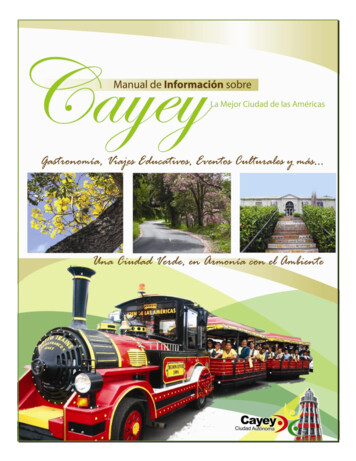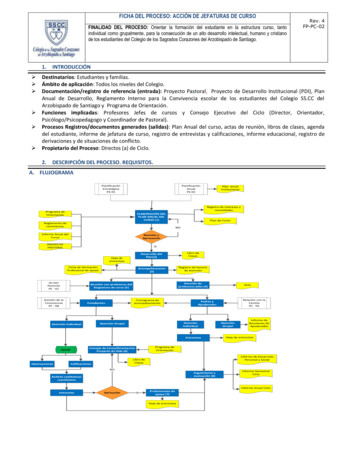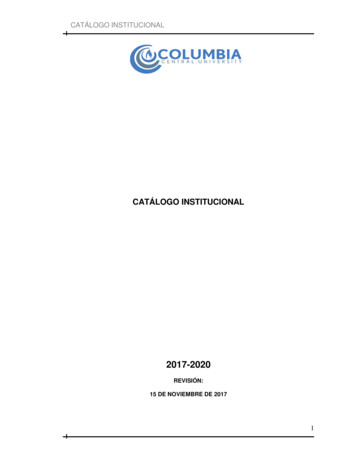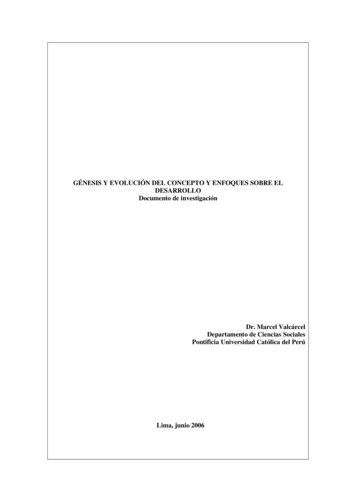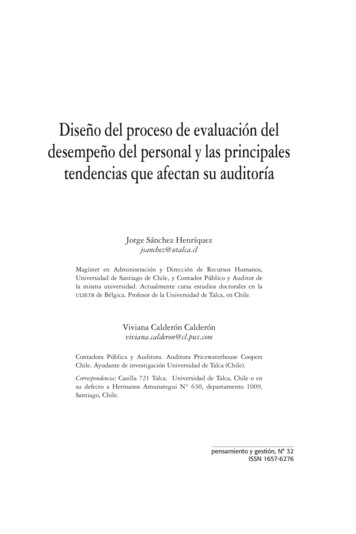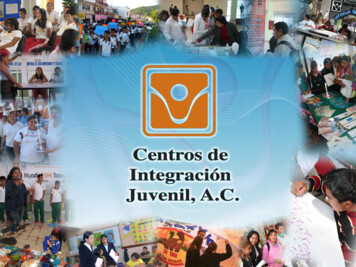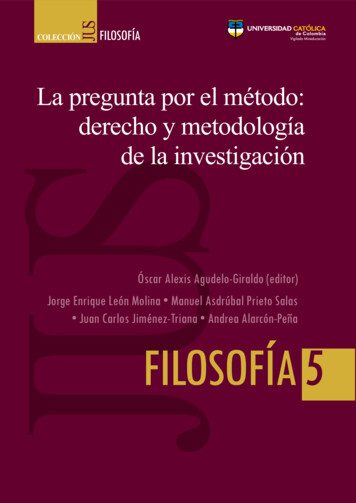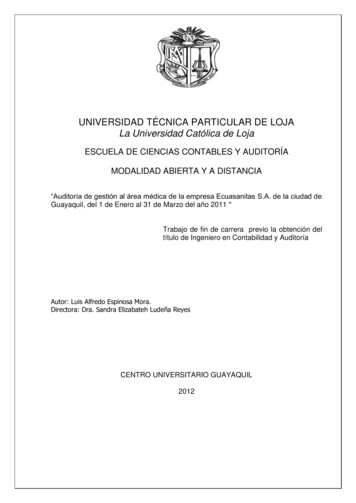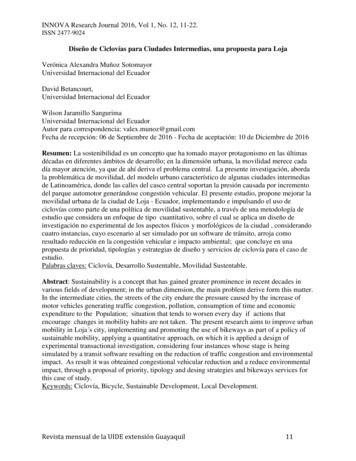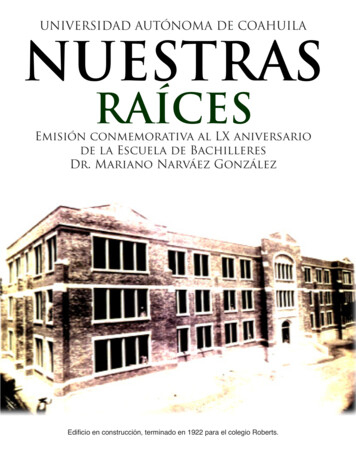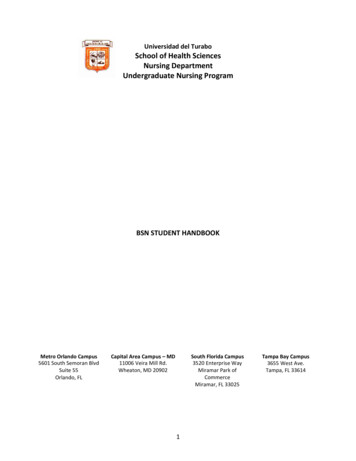
Transcription
Universidad del TuraboSchool of Health SciencesNursing DepartmentUndergraduate Nursing ProgramBSN STUDENT HANDBOOKMetro Orlando Campus5601 South Semoran BlvdSuite 55Orlando, FLCapital Area Campus – MD11006 Veira Mill Rd.Wheaton, MD 20902South Florida Campus3520 Enterprise WayMiramar Park ofCommerceMiramar, FL 330251Tampa Bay Campus3655 West Ave.Tampa, FL 33614
TABLE OF CONTENTSPageWelcoming Letter . 4I.INTRODUCTIONA. Purpose of the Handbook . 5B. Program Accreditation and Memberships . 5C. Organizational Chart. 5D. History of Nursing Program . 5E. Mission Statement . 5F. Philosophy . 6G. Overview of the BSN Program1. Core Courses. 92. Specialty Courses . 103. Graduate Profile of the BSN . 15II.GENERAL POLICIESA. Student Responsibilities . 15B. Student Expectations . 16C. Student Representation on Departmental Committee. 15D. Confidentiality of Records. 16E. Health Requirements. 17F. Hepatitis B Vaccination . 17G. Negative Criminal Record evidence .H. CPR Training .I. Confidentiality . 18J. Infection Control in Clinical Settings . 18K. Unprotected Exposure. 19III.Academic PoliciesA. Admission . 20B. Standards for Academic Progress. 21C. Graduation . 21D. Semester load . 21E. Absences. 21F. Grades . 22G. Completion of Degree Requirements. 23H. Withdrawals . 23I. Incomplete (I) Grades . 23J. Transfer Credits into the Graduate Program. 232
K.L.M.N.O.Computer Literacy . 23Academic Advising. 23Confidentiality and Privacy of Client Information . 24Academic Honesty . 24Student Grievance Policy . 26VI. MiscellaneousA. Financial Aid . 26B. General Dress Code Policies . 27C. Uniform Policies . 27D. Cellular Phones and Pagers . 28VII. Appendix. 293
ANA G. MENDEZ UNIVERSITY SYSTEMSUNIVERSIDAD DEL TURABOSCHOOL OF HEALTH SCIENCESNURSING DEPARTMENTUNDERGRADUATE NURSING PROGRAMBSN STUDENT HANDBOOKDear Nursing Student:Welcome to the Bachelor of Science in Nursing (BSN) Program, a part of the Nursing Department(ND) at the School of Health Sciences (SHS), Universidad del Turabo (UT).The history of the Ana G. Méndez University System (SUAGM) is rich in experiences of growth andexpansion and a reflection of the standards set by Doña Ana G. Méndez from the beginning:education is a right for all.In 2003, SUAGM took its first steps outside of Puerto Rico with the establishment of the MetroOrlando Campus in the city of Orlando, Florida, which was followed by campuses in South Florida,Tampa, and Maryland.From its humble beginnings, SUAGM has grown to be an international organization offeringHispanics of every background the opportunity to improve, given that this demographic group isthe fastest growing in the United States. By establishing new programs outside of Puerto RicoSUAGM’s expansion becomes the ultimate expression of Doña Ana’s vision: to provide access andopportunity not only to Puerto Ricans, but also to fellow Hispanics from every country.As part of the nursing program you will be expected to complete the courses that will ultimatelylead to a Bachelor of Science in Nursing (BSN) degree, which will prepare you to practice as a nurseand provide a basis for future graduate study.We welcome you and look forward to assisting you in achieving your goals as a professional nurse.Sincerely,The Undergraduate Nursing Faculty4
BSN STUDENT HANDBOOKIII.INTRODUCTIONA. Purpose of HandbookThis handbook has been prepared by the undergraduate nursing faculty as anorientation guide of policies, procedures, and other information specific to theundergraduate program. The information in this handbook is as accurate as isrealistically possible; however, the contents may change periodically. Due notice willbe given to all students when changes are made to policies contained in the handbook.If there are questions about any of the information contained in this document, do nothesitate to contact the Dean or his/her representative for clarification.B. Program Accreditation and MembershipsThe program has full accreditation through the Council on Higher Education in PuertoRico and the Continental US, Middle States Association of Colleges and SecondarySchools (re-accreditation from 2005 to 2015) and the Commission of Collegiate NursingEducation (CCNE). The Nursing Program holds membership in the American Associationof Colleges of Nursing (AACN).C. Nursing Programs HistoryIn the year 1998, UT established the School of Health Sciences (SHS) with the goal ofoffering academic programs that satisfy the needs of the east–central region of theisland of Puerto Rico. This effort started with the Bachelor degree in Nursing Sciences(BSN), in April 2000. At the graduate level, SHS started the Master’s degree of Sciencein Nursing with a specialty in Family Nurse Practitioner in March 2004 and later addedtwo other programs: MSN with a specialty in Occupational and Environmental HealthAdult Nurse Practitioner and MSN with a specialty as Clinical Nurse Leader.D. Nursing Program Mission StatementThe primary mission of the School of Health Sciences is to prepare excellent humanresources in Health Sciences with innovative academic offerings across the curriculumthat can respond properly and rapidly to the needs of local and global communities.With the current gaps in health care services, Puerto Rico and the Continental US needwell-trained nurses with increased knowledge and skills to provide care. The studentsin the Undergraduate Program are encouraged to maintain a holistic perspective in thehealth care they provide with a multidisciplinary and collaborative focus throughoutthe individuals life span.The primary mission of the nursing faculty of this program is to prepare nurses who canbe key members of an interdisciplinary team that provides positive impact on healthcare outcomes.5
E. Nursing Program PhilosophyThe philosophy of the Community Health Systems Department for the undergraduateprogram is consistent with the goals and mission of Universidad del Turabo and theSchool of Health Sciences. The federal creations of Healthy People 2000 and HealthyPeople 2010-2020 have set goals in many specific areas, including health promotionand disease prevention. Since the challenge of improving the nation’s health is, aninterdisciplinary one nursing education must anticipate and prepare for these changesin order to educate its students for this new environment.Undergraduate ProgramWe believe that preparation for the entry-level nurse now requires a greaterorientation to community-based primary health care and an emphasis on healthpromotion, maintenance and cost-effective coordinated care. This care must respondto the needs of culturally diverse, underserved groups and other populations in avariety of settings. The nursing faculty at the School of Health Sciences concurs withthe AACN position statement that recognizes the degree in Bachelor of Science inNursing as the minimum educational requirement for professional nursing practice.The philosophy of the Nursing Programs is based on the Dimensions Model ofCommunity Health Nursing (Clark, 1996). The dimensions model consists of threeelements: dimensions of health, dimensions of health care and dimensions of nursing.Figure 1. Clark’s Dimensions Model of Community Health NursingThe Dimensions of HealthThe dimensions of health guide the nurse’s assessment ofThe biophysicaldimensionincludesfactorsto humanclients’he whetherthe clientis anrelatedindividual,a familybiologyor a that influencehealth andcommunity.may be relatedto age and developmental stages, genetics, andThe dimensiophysiologic function. The psychological dimension refers to health effects of both6
internal and external psychological environments. The physical environmentaldimension encompasses the health effects of factors in the physical environment.The sociocultural dimension consists of those factors within the social environmentthat influence health, either positively or negatively. The behavioral dimensionconsists of personal behaviors that either promote or impair health. The healthsystem dimension refers to the way in which health care services are organized. Thisdimension also evaluates how available, accessible, affordable, appropriate,adequate, and used are these services.The nursing faculty believes that nurses need to be educated about the applicabilityof this model. Correct use of the dimensions of health to collect and organize dataregarding client health status is of great importance. Factors in each of the sixdimensions are applied through the undergraduate and graduate curricula atmultiple levels, including individuals, families, groups, and communities. From thisdata, the nurse derives health diagnoses that guide the planning of nursinginterventions.The Dimensions of Health CareNursing interventions for identified health needs are planned within the dimensionsof health care, which are derived from the epidemiologic perspective of public health.These interventions are identified taking into consideration the interaction ofmultiple factors in population health and illness. The dimensions of health careinclude primary, secondary, and tertiary prevention. Primary prevention focuses ontaking action prior to the occurrence of health problems and includes aspects ofhealth promotion and protection. Health protection aims at preventing theoccurrence of specific health problems by eliminating risk factors that producedisease. Secondary prevention focuses on the early identification and treatment ofexisting health problems. Tertiary prevention is an activity aimed at returning theclient to the highest functional level and preventing further deterioration of health.The Dimensions of NursingThe dimensions of nursing include the cognitive, interpersonal, ethical, skill, process,and reflective dimensions. The cognitive dimension encompasses the knowledgeneeded for the nurse to identify client health needs and to plan and implement careto meet those needs. The interpersonal dimension includes affective elements andinteraction skills. Affective elements consist of the attitudes and values of the nursethat influence his/her ability to practice effectively. Interaction skills and the abilityto collaborate and communicate effectively with others are important elements ofthe interpersonal dimension.The ethical dimension includes moral and ethical principles, which are essentialelements in nursing. Nurses must be able to make ethical decisions targeted toalways decide what is best for the client and to be his/her advocate. The skills7
dimension encompasses manipulative and intellectual skills, common to all aspectsof nursing practice. Manipulative skills require performance of different proceduresand intellectual skills include capacities for critical thinking.The process dimension refers to specific processes used in the provision of care:nursing process, epidemiologic process, health education, home visits, casemanagement, change process, leadership process, group process, and politicalprocess. The most fundamental process, according to this model, is the nursingprocess. Nursing actions occur in the context of the nursing process. The dimensionsof health are used to guide assessment of the client’s health status and to derive ata nursing diagnosis. The dimensions of health care direct the planning,implementation, and evaluation of nursing interventions.The faculty believes that nursing is an art and a science; a discipline oriented towardsthe diagnosis and treatment of actual or potential health problems. Nursing involvesobservations, interactions, and analysis of interventions with families, groups andcommunities. These interventions take place in a variety of scenarios and at primary,secondary, and tertiary prevention levels.The nursing professional assumes different roles according to the time and situation;therefore, the necessary knowledge, skills and competencies are essential, accordingto the role assumed. All nurses must demonstrate excellent decision-making,problem-solving and critical thinking skills in order to affect the health care deliverysystem.An essential domain in the education of nursing professionals is the concept of theclient being in constant interaction with the environment. The client is continuouslyevolving, and his/her behavior is a manifestation of the interaction with theenvironment. Each person is responsible for the decisions that affect their health.Health is viewed, as a dynamic state where individuals take responsibility for theirquality of life by meeting different needs. Nursing interactions are focused on healthpromotion and disease prevention. When the person is not able to maintain theirhealth the nursing professional uses therapeutic interventions with the purpose ofassisting the individual in the process of health restoration.Theoretical frameworks, research, and scientific knowledge are important processesin which nurses develop, validate, and communicate problems. Practice, education,and administration/leadership are the bases for nursing care, which is performed incollaboration with other members of an interdisciplinary health care team. Thenurse’s role is that of a health care provider who both, independently and incollaboration with others, assesses, plans, implements, and evaluates nursing care.The client has biophysical, psychological, physical-environmental, and behavioraldimensions. Illness is the result of a loss of balance between those dimensions as a8
product of the relationship between the client, and the environment. The health ofindividuals, families, and communities is affected by this imbalance. Due to thisconstant interaction of individuals with their environment, the three levels oftherapeutic interventions are directed toward achieving the client's goal of optimumhealth.F. Overview of the BSN programA. Title of the ProgramBachelor in Sciences of Nursing (BSN).B. Duration of ProgramThe Bachelor in Sciences of Nursing consists of 121 credits.G. Overview of the ProgramCORE COURSESFSHS 105 – Freshman Seminar in Health Sciences (3 credits)The focus of this course is to strengthen basic knowledge and skills at a personal,intellectual and technological level necessary to succeed in the activities of academicperformance and adjustment to university life. Each student will participate inmentorship activities that will continually build upon skills and knowledge base in theadvancement of student development. Important emphasis is given to the integraldevelopment of humanistic fulfillment and academic success. The student is guidedthrough a series of activities on the university campus exposing them to the servicesoffered by the institution, and the School of Health Sciences. The goal will translateinto the student feeling secure and confident in managing and solving personal andacademic situations.HESC 350 – Reconceptualizing Aging (3 credits)This course is directed to undergraduate students who are interested on developing,strengthening and expanding their knowledge, attitudes and skills in the care of theolder adult and need to develop interdisciplinary work skills. The course is intendedto serve as an elective for undergraduate programs in the health and behavioralsciences, disciplines that focus in the care and services to the older adults, regardlessof their clinical setting. These disciplines also, have direct contact with these clientsas a response to the nature of their professional services. Students will have theopportunity to clarify myths and stereotypes about aging, gain a new vision of theaging concept and become familiar with the sociodemographic profile of the elderly.The course also discusses social, biological and psychological changes in aging, theirimpact into services to the elderly and the uniqueness of older persons. The mostprevalent conditions and problems that affect the functional status and fundamentalconcepts of interdisciplinary teamwork will be also addressed. Students9
will have the opportunity to interview older adults in the home setting to estimatetheir functional status and perform interdisciplinary teamwork.HESC 360 – Statistic Applied to Health SciencesThis is the third core course required to be completed by all students completing BSstudies at the School of Health Sciences except students from Speech LanguageTherapy, Dietetic, and Nutrition, who are encouraged to take it as an elective.Provides a discussion of statistical methods applied to the health professions. In thiscourse, the student expands on the knowledge introduced in HESC 340-HealthSciences Research. Emphasis is given to qualitative and quantitative statisticalanalyses applied to clinical research according to different research designs.Pre-requisites: MATH 120HESC 370 – Transcultural Nursing (3 credits)This course is offered at the undergraduate level to apply a transcultural nursingframework to guide nursing practice in diverse health care settings across thelifespan. Considering that, nursing care requires effective communication skills, aclear understanding of the cultural beliefs and preferences of clients, students areintroduced to the development of cultural assessment skills. These combined withcritical thinking and decision-making abilities based on cultural knowledge, willprovide the necessary competence on which to base transcultural nursing care. Usingthis approach, nurses will be able to provide culturally competent and contextuallyrelevant care for clients-individuals, families, groups, communities, and institutions.HESC 365 – Health Sciences Research (3 credits)This core course is required for undergraduate students at the School of HealthSciences. Specific attention is given to the relationship between research outcomesand clinical practice. This course prepares students to critically analyze researchliterature in the health sciences. Students also have the opportunity to apply thescientific method to clinical research. Funding opportunities available to developresearch studies in health sciences are presented and discussed.Pre-requisites: HESC 360SPECIALTY COURSESNURS 200 - Introduction to Nursing: A New Community (3 credits)The focus of this course is to increase awareness of the nurse’s role as a professionalin the community at large, the realities of the profession and opportunities itrepresents. This course emphasizes the basic concepts of nursing, health, illness, aswell as the emotional, spiritual, psychosocial and physiological components of thehuman being. The students will participate in two nursing workshops related to basicprocedures in addition to familiarizing them with instrument and equipment fromthe skills laboratory. Through a series of activities, the student is exposed to universitylife including aspects of cultural and nursing professional life.10
NURS 201 – Fundamentals of Nursing (5 credits)This theoretical and clinical course introduces the historical, sociopolitical, and legalconcepts of the nursing profession in US, Puerto Rico and other Hispaniccommunities. Emphasis is given to the development of nursing basic skills, which areneeded for the health promotion, and maintenance of individuals, families andcommunities. The student is guided to consider the individuals motivation in seekinghealth care and how their problems interfere with daily activities. Clinical practiceprovides opportunities for the development of the necessary skills used in hospitaland community settings to carry out the nursing role. Emphasis is placed on the clientas a holistic being and the use of critical thinking when intervening in health andillness with a variety of individual is from different cultural/social backgrounds, anddifferent age groups.NURS 202 – Health and Physical Assessment (4 credits)This course focuses on health promotion and disease prevention concepts forconducting physical examinations and health assessments. Multidisciplinary andinterdisciplinary collaboration, cultural competence and professional interpersonalskills are modeled in order to achieve the goals of Healthy People 2010. Practice inthe skills laboratory provides an opportunity for the students to examine andimplement the nursing process with individuals, families and communitiesthroughout the life span as consumers and resources of health care. The nursingdiagnosis process, health screening, referrals process, and physical examinationtechniques are discussed, applied, and practiced in laboratory experiences.NURS 203 – Pharmacology (4 credits)This course presents students with the opportunity to develop critical thinkingrelated to pharmacology concepts applied to the nursing process. The contentfocuses on principles of pharmacology, drug classifications, administration routes,dosage calculations, therapeutic use, disinfection procedures, basic concepts ofnontraditional medicine and drug interactions, and discussions of advantages anddisadvantages of pharmacotherapy and the client's well-being. In addition, thiscourse includes content on bioterrorism agents, drugs for HIV/AIDS, medicationerrors and gene therapy.Pre-requisites: NURS 201, NURS 202NURS 205 – Pathophysiology (3 credits)This course presents the basic concepts of human pathophysiology and explains theprocesses of specific diseases. The course is divided in two parts: the micro and macrosystems. Part one reviews cellular responses to infection, environmental factors,genetics, diet, cancer and stress. Part two is organized by body systems. Students areexpected to have a basic knowledge of microbiology, chemistry, anatomy and11
physiology. Relevant case studies are discussed in class, and aspects such as riskfactors pertinent to pediatric, aging and women's health are presented.Pre-requisites: NURS 201, NURS 202NURS 209 - Nutrition Essentials for Nursing Practice (3 credits)This is a course offered to undergraduate nursing students (BSN) as an electiveoption. The course is designed to fill the need for clinical nutrition education fornursing students. Discussion of the fundamentals of nutritional care includingnutritional assessment, identifying risk factors, determining nutrient requirements,and selecting appropriate interventions. Life cycle nutrition, functional elements ofnutrition support, trends in nutritional care, and nutritional considerations in specificdisease states are also covered.Pre-requisites: NURS 201NURS 210 – Nursing Informatics (3 credits)This course is an introduction to computers and nursing informatics focusing onapplicants to the nursing profession. The emphasis is on integrating nursing practicesystems and informatics technology. The student explores the use of informatics inthe nursing practice and its role in enhancing patient care. The student also examinesissues related the protection of the privacy, confidentiality, and security of healthinformation in health care environments and the potential utility of a wide array ofsocial networking tools in communicating health-related information.Pre-requisites: MATH 120, HESC 360, HESC 365, NURS 303, 304 & 305NURS 212 – Nursing Care of the Older Adult (3 credits)This course focuses on the care of the older adult. Prepare undergraduate studentsto provide holistic, professional nursing care. It also present common problems ongeriatric syndromes and then impact on functional status of the older adult and theinterdisciplinary team look as effective strategy in their care. It focuses primarily onfunctional assessment, effective communication and nursing interventions to fosterfunctionality even through risk and the aging process.Pre-requisites: NURS 200, NURS 201, NURS 202, NURS 203, NURS 205NURS 303 – Medical Surgical Nursing (5 credits)This theoretical and clinical course prepares the students to intervene withindividuals in the adult and elderly stages, who present physiological alterations thataffect their homeostasis. The focus is directed towards the development ofknowledge based on application of the nursing process, communication skills, criticalthinking and therapeutic interventions as essential to ensure an optimal care. Thecourse includes theory, nursing skills laboratory, clinical experiences (hospitals &communities) and seminars. The hospitals used for clinical practice are at secondaryand tertiary levels of care.Pre-requisites: NURS 201, NURS 20212
NURS 304 – Maternal & Child Nursing (5 credits)This theoretical and clinical course focuses on concepts of the childbearing client, herinfant and the impact in her family. The nursing process is presented as a guide forintervention with families during the normal human development process including:pregnancy, delivery, post-partum and care of the newborn. Health promotion isemphasized. Epidemiology, infectious, acute and chronic diseases are discussedtaking into consideration maternal and newborn's needs in community and hospitalcare settings from a biopsychosocial perspective. At the beginning of the course,specific maternal and childcare skills are practiced in a nursing skills laboratory. Afterthis practice, students participate of different experiences in the clinical setting.Pre-requisite: NURS 303NURS 305 – Nursing Care of Children and Adolescents (5 credits)This theoretical and clinical course focuses on the care of children and adolescents.The student is introduced to the concepts of nursing care from the first year of life tothe adolescence. Nursing basic skills are developed for the prevention of illness,health promotion and health maintenance in this age group. Emphasis is placed onthe client as a holistic being, applying critical thinking and promoting the use ofnursing diagnosis according to North American Nursing Diagnosis Association(NANDA) with nursing interventions (NIC) and outcomes (NOC) adequate to this agegroup.Pre-requisite: NURS 304NURS 403 – Community Health Nursing (5 credits)This theoretical and clinical course focuses on the study of principles and practicesinvolved in community health nursing and the development of skills for healtheducation in community settings. Students are familiarized with models, theories,concepts and skills related to community interventions. Public
Universidad del Turabo School of Health Sciences Nursing Department Undergraduate Nursing Program BSN STUDENT HANDBOOK Metro Orlando Campus 5601 South Semoran Blvd Suite 55 Orlando, FL Capital Area Campus - MD 11006 Veira Mill Rd. Wheaton, MD 20902 South Florida Campus 3520 Enterprise Way Miramar Park of Commerce Miramar, FL 33025

